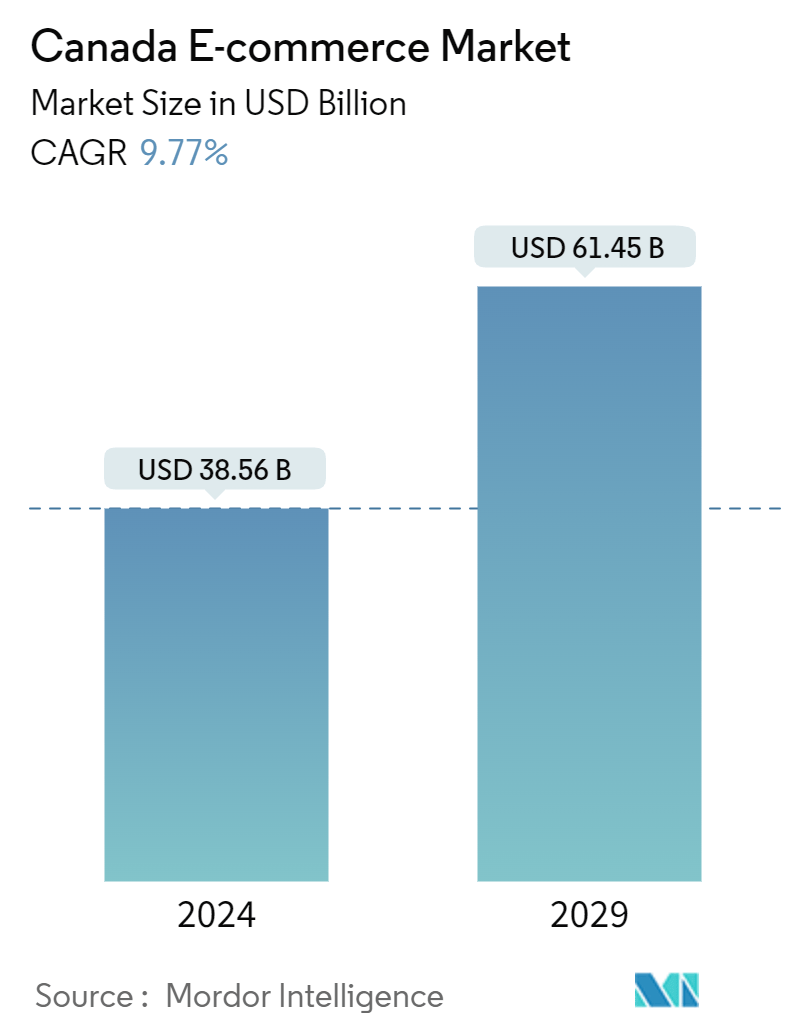Market Size of Canada E-commerce Industry

| Study Period | 2019 - 2029 |
| Base Year For Estimation | 2023 |
| Market Size (2024) | USD 38.56 Billion |
| Market Size (2029) | USD 61.45 Billion |
| CAGR (2024 - 2029) | 9.77 % |
| Market Concentration | Medium |
Major Players
*Disclaimer: Major Players sorted in no particular order |
Canada E-commerce Market Analysis
The Canada E-commerce Market size is estimated at USD 38.56 billion in 2024, and is expected to reach USD 61.45 billion by 2029, growing at a CAGR of 9.77% during the forecast period (2024-2029).
- The e-commerce market in Canada is growing significantly, driven by the high Internet and mobile penetration, changing consumer behavior, and secure and diverse payment options. The Canadian consumer landscape is characterized by high internet penetration and a growing preference for online shopping. Over 90% of Canadians have access to the Internet, and a significant portion of this population engages in online shopping.
- Canadian consumers appreciate the convenience, variety, and competitive pricing offered by e-commerce platforms. Additionally, mobile commerce is rising in Canada, with more consumers using smartphones and tablets for shopping. According to the report by BIP (Canada), smartphone use for the Internet reached 44% in 2023. This trend underscored the importance of mobile-optimized websites and apps for retailers.
- Further, with a large percentage of the population connected to the Internet, the potential customer base for online retailers is substantial. The widespread use of smartphones further enhances the accessibility and convenience of online shopping. Also, efficient logistics and delivery networks, including same-day and next-day delivery options, play a crucial role in enhancing the e-commerce experience. Companies like Canada Post and Purolator have expanded their capacities to meet the growing demand.
- In Canada, many physical retailers have expanded their online presence, integrating e-commerce into their business models. This omnichannel approach allows retailers to reach a broader audience and offer a seamless shopping experience. Also, the rising middle class and increasing disposable income levels in Canada have fueled demand for consumer electronics products such as smartphones, laptops, tablets, and smart home devices. As consumers become more tech-savvy and aspire to upgrade their lifestyles with the latest gadgets, they increasingly turn to e-commerce platforms for their purchases.
- The e-commerce landscape in Canada is poised for further growth in the coming years. As technology advances and consumer tastes evolve, e-commerce firms are under pressure to adapt swiftly and innovate to retain their competitive edge. Prioritizing customer experience, integrating cutting-edge technologies, and tackling logistical hurdles are imperative strategies for driving sustained growth in this ever-evolving market.
Canada E-commerce Industry Segmentation
E-commerce is the buying and selling of goods and services over the Internet through online shopping. However, this term is often used to describe a seller's efforts in selling products directly to consumers. It begins when potential customers learn about a product, buy it, use it, and ideally maintain lasting customer loyalty. The report's scope includes market sizes and forecasts for B2B and B2C e-commerce.
The Canada e-commerce market is segmented by B2C e-commerce (beauty and personal care, consumer electronics, fashion and apparel, food and beverage, and furniture and home) and B2B e-commerce. The market sizes and forecasts are provided in terms of value (USD) for all the above segments.
| By B2C E-commerce | ||||||||
| Market size (GMV) for the period of 2017-2027 | ||||||||
|
| By B2B E-commerce | |
| Market size for the period of 2017-2027 |
Canada E-commerce Market Size Summary
The Canadian e-commerce market is experiencing significant growth, driven by advanced infrastructure, high internet penetration, and the adoption of card-based payment systems. The market is characterized by a strong presence of major players like Amazon, which dominates the sector with its extensive range of offerings, including electronics, books, and streaming services. The pandemic has accelerated the shift towards online shopping, with Canadians increasingly embracing digital wallets and other non-traditional payment methods. This shift has led to a transformation in the retail landscape, with small businesses adopting e-commerce platforms to reach a broader audience. The trend towards mobile payments and the rollout of 5G technology are further enhancing the e-commerce experience, making it more accessible and convenient for consumers.
Canadian consumers are increasingly relying on the internet for their shopping needs, with a significant portion of retail sales now occurring online. The market shares similarities with the United States, with trends such as hybrid purchases and omnichannel shopping gaining traction. Social media marketing is becoming a key strategy for retailers, as it offers a high return on investment. The dominance of Amazon.ca, followed by Walmart.ca and HomeDepot.ca, highlights the competitive nature of the market, with these top players accounting for a substantial share of online revenue. The growth of e-commerce is reflected in the rising number of online shoppers and the increasing volume of purchases, with electronics, fashion, and furniture being the leading product categories.
Canada E-commerce Market Size - Table of Contents
-
1. MARKET INSIGHTS
-
1.1 Market Overview
-
1.2 Industry Attractiveness-Porter's Five Forces Analysis
-
1.2.1 Bargaining Power of Suppliers
-
1.2.2 Bargaining Power of Buyers/Consumers
-
1.2.3 Threat of New Entrants
-
1.2.4 Threat of Substitute Products
-
1.2.5 Intensity of Competitive Rivalry
-
-
1.3 Key market trends and share of E-commerce of total Retail sector
-
1.4 Impact of COVID-19 on the E-commerce sales
-
-
2. Market Segmentation
-
2.1 By B2C E-commerce
-
2.1.1 Market size (GMV) for the period of 2017-2027
-
2.1.2 Market Segmentation - by Application
-
2.1.2.1 Beauty & Personal Care
-
2.1.2.2 Consumer Electronics
-
2.1.2.3 Fashion & Apparel
-
2.1.2.4 Food & Beverage
-
2.1.2.5 Furniture & Home
-
2.1.2.6 Others (Toys, DIY, Media, etc.)
-
-
-
2.2 By B2B E-commerce
-
2.2.1 Market size for the period of 2017-2027
-
-
Canada E-commerce Market Size FAQs
How big is the Canada E-commerce Market?
The Canada E-commerce Market size is expected to reach USD 38.56 billion in 2024 and grow at a CAGR of 9.77% to reach USD 61.45 billion by 2029.
What is the current Canada E-commerce Market size?
In 2024, the Canada E-commerce Market size is expected to reach USD 38.56 billion.

